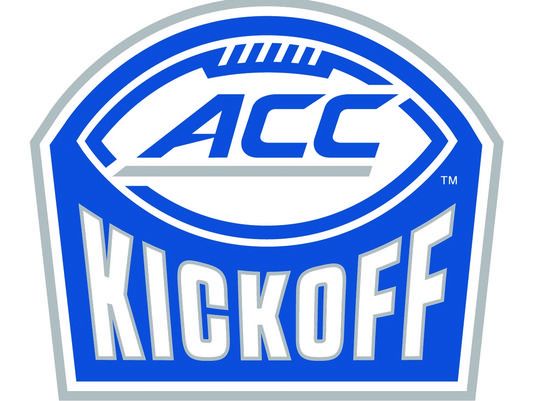Turnover Chain “Greatest Thing Since The 10-Bite Sandwich”
While Larry Fedora was setting himself on fire in front of the press today, Miami’s Mark Richt may have had the quote of the day when asked about his reaction to one of the more publicized – and annoying – gimmicks in college football last season: the turnover chain.
“What’s been my reaction? It’s the greatest thing since sliced bread.” Richt said. “It’s really the greatest thing since the 10-bite sandwich, actually. People ask me about that — first of all, I didn’t know about the turnover chain until the first game. Coach Diaz is like, hey, Coach, by the way, we’ve got this chain, in case we get a turnover we’re going to put it on their neck.

“I said, All right, that’s cool. I said, It’s kind of big and gaudy. I said, Well, we’re in Miami, that’s all right, it’s no problem. So I really didn’t know much about it. I had never seen it. I had never touched it.”
Then the chain was awarded for the first time during a game.
“I’m on the sideline looking at the game, and behind me is when all the party is going on, I didn’t know what was going on,” Richt said. “It wasn’t until the night of the first game that I looked on social media and saw Malek Young with the big grin and that big chain on his neck.
“I don’t even think I touched it until the season was over. That thing is about six pounds. I mean, it is a thick, Cuban link chain with that big U. It is gaudy and it’s beautiful. But like I’ve said all year long, or since the season ended, if we got three turnovers last year, it would have been mocked. It would have been laughed at. But when you get 31 turnovers or whatever it was, maybe there’s something to it.”
********************************
ACC and the College Football Playoffs: It wasn’t so long ago that national pundits predicted that ACC football would be left out of the college football playoff picture. Little did they realize that the ACC would win the final BCS Championship game (Florida State), and that the ACC would have a representative in all four of the CFP events.
What transpired to elevate the league’s national football status? Swofford said it isn’t easily explained but believed he had a root answer for the ACC’s gridiron success.
“One was to grow and enhance our footprint and our marketplaces and our television sets, and the other was that we had to get more competitive top to bottom in football,” Swofford said. “Those were the two items that we beat to death, quite honestly, meeting after meeting after meeting, and we got there.
“But the success on the field doesn’t happen, and certainly I think we enhanced ourselves football-wise by the schools that we have brought into the league since the decision first was made in 2003 [to expand].”
All that said, Swofford believes the underlying reason the ACC has become a strong football league is because the member schools responded to the challenge to improve football, bringing it up to the same national level of ACC basketball.
“I think we’re in the best shape we’ve ever been as a league at this point in time in a real balance with football and basketball,” Swofford said. “But the biggest thing is the schools responding, investing the [football], investing in facilities, investing in hiring quality coaches, and investing in recruiting.”
The commish pointed out that over the past two seasons that ACC football teams have made 21 bowl appearances, which leads the nation, and that the ACC football champion has been in the College Football Playoff every year of the new format’s existence.
“We have seven of the nation’s top 25 active coaches in career victories, that’s more coaches in that top 25 than any other conference,” Swofford said.
****************
Rice Commission Recommendations: Commissioner Swofford said that he believes the vast majority, if not all of Condolezza Rice’s recommendations for cleaning up college basketball will be adopted by the NCAA next month.
“And I think it needs to be adopted,” Swofford said during Wednesday’s ACC Football Kickoff media day in Charlotte. “That doesn’t mean that I agree with every piece of it, but I think what we need to do right now with college basketball is to show a commitment to adopting those concepts, and they’ll be more than concepts when they’re adopted in August.”
Swofford believes those concepts will be converted into legislative protocol quickly, within a year or two, although some of the concepts may need some tweaking.
“I think the bones of it are outstanding, and I think we’re at a point in college basketball where we need to take those steps,” the commissioner said. “I don’t think it will be perfect in August, so I think we’re going to need a mechanism to adjust to some degree going forward, but I think it’s important to take that first step, and I think it needs to be a giant first step.”
****************
Rule changes for 2018: Toward the end of the first day of the ACC Kickoff, ACC supervisor of officials Dennis Hennigan explained this season’s rules changes. He pointed out that the way the NCAA rules process works, it’s on a two-year cycle. In year one, (this year), all rules can be looked at to be changed or amended. In year two of a two-year cycle, only player safety rules can be addressed.
First rule change discussed was the kickoff rule. “If a member of the receiving team fair catches a kickoff inside his 25 yard line, they will next snap the ball at the 25 yard line,” Hennigan explained. “This is obviously an attempt by the Rules Committee to reduce the number of kickoff returns. I think their data shows that — not that there’s more fouls on kickoffs than other plays, but that there are more significant fouls, if you will, on kickoffs than on other plays. So the Rules Committee thought let’s take this one step this year, see what the data shows at the end of the year and then decide what, if any, additional changes will be made. So you fair catch a kickoff inside the 25, you get the ball at the 25.”
All rules have situations where there could be confusion. This one is no different.
“Fullback signals for a fair catch at the 30 yard line, and the deep receiver catches the ball at the ten yard line,” Hennigan used as an example. “You do not get the benefit of this new rule. It will be your ball at the ten yard line. Only a player who in the terms of the rule book “makes a fair catch, “gets the benefit of this new rule. In order to make a fair catch you have to have signaled.
“So if one player signals a player who did not signal catches the ball it would be the receiving team’s ball at the spot where the ball is caught. Now, it’s perfectly legal for more than one player to signal for a fair catch on a play. You could have all 11 players signal for a fair catch, that’s not a foul. Again, if a player catches the ball who did not signal, then you don’t get the benefit of this rule and it will just be your ball where the ball was caught.”
The other rule Hennigan explained involved changes made to the blocking below the waist rule.
“The general rule now is that all blocks below the waist have to be from the front,” Hennigan said. “In other words, the player being blocked has to be able to see the player who is coming at him to block him. That’s what it means from the front. So that’s the general rule.
“Now the exception to that is for the five offensive linemen. They can block below the waist from the side, inside the tackle box, so long as the ball is inside the tackle box. Where we typically see this, say a play is run to the left, the right guard or the right tackle will reach, block, and cut the defensive lineman from the side, and that’s perfectly legal. Again, inside the tackle box, the ball is inside the tackle box.
“What that offensive lineman can’t do is go and block a linebacker low from the side. So, again, same play you’re running it from the left side, and the right tackle’s job is to get to that linebacker and cut off pursuit. He cannot go and block that linebacker low from the side.”
One facet most people may not be aware of, is if you’re more than 5 yards from the line of scrimmage, it doesn’t matter what side you block from. You can’t block below the waist.
“One other change has to do with what has been known as a crackback block: a player on the outside coming back toward the ball and cutting a player, cutting a defensive player,” Hennigan said. “Last year the rule was you could do that once the ball carrier had crossed the line of scrimmage, and provided that block was from the front. Now you can’t do it. There is no blocking below the waist back toward the ball even if the block is from the front.”








